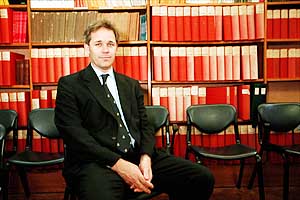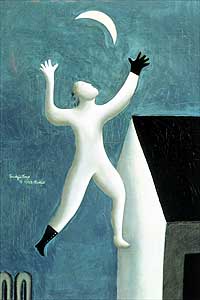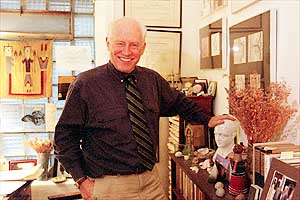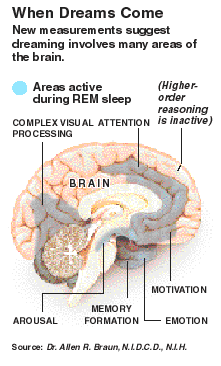|
November 2, 1999
New Clues to Why We Dream
ForumJoin a Discussion on Health in the News
By ERICA GOODE
Yasuda Kasai Museum of Art, Tokyo/Equitable Gallery
In his 1929 "Surrealistic Stroll," Seiji Togo enters the world of the dreamer. It is part of an new exhibit marking commemorating Freud's work.
o Sigmund Freud, whose classic book, "The Interpretation of Dreams," arrived in the bookstores of Vienna 100 years ago this month, dreams were filled with latent meaning, their bizarre imagery and peculiar narratives concealing deep-seated, instinctual motives and desires.
Modern neuroscientists, however, have cast the products of nightly repose in a different light. Laboratory studies in the 1960's and 70's linked dreams not to hidden urges but to the firing of neurons and oscillation of chemicals in the most primitive part of the brain during the arousal of "rapid eye movement," or REM sleep.
Dreaming, in this conception, was random and chaotic, the mind's attempt to take account of the brain's revved-up physiology. Higher brain centers -- the crucibles of thoughts, emotions and memories -- were merely passive responders, making "the best of a bad job in producing even partially coherent dream imagery from the relatively noisy signals sent up from the brainstem," as Dr. Allan Hobson and Dr. Robert McCarley of Harvard, authors of the "activation-synthesis" model of dreaming, put it in a 1977 paper.
Freud, in other words, could not have been more wrong. Or so it seemed.
But in recent years, new work has forced scientists to rethink their understanding of dreaming and the brain, granting a more active role to parts of the brain involved with feeling, memory and vision.
The new findings neither validate the particulars of Freudian theory nor prove that dream interpretation is, as Freud asserted, "the royal road to a knowledge of the unconscious activities of the mind."
And some scientists, Dr. Hobson among them, see little in the new work to bolster Freud's case.
But neither are the results inconsistent with psychoanalytic thinking. And they have been eagerly pounced upon by many psychoanalysts, who say that they offer a biological foundation for at least some of what the Viennese doctor deduced from treating neurotic patients a century ago.
"Twenty years ago," said Dr. Mark Solms, lecturer in neurosurgery at St. Bartholomew's Hospital in London, who is both a neuropsychologist and a psychoanalyst, "Freudian dream theory seemed absolutely untenable. Today, what we know about the brain mechanisms of dreaming is far more compatible with what Freud inferred."

Justin Leighton/Network for The New York Times
Neurologists like Dr. Mark Solms, top, and Dr. Allan Hobson disagree over the significance of dreams.
Some of the new insights into dreaming have come from the development of neuroimaging techniques that allow investigators to observe the living brain. In one series of studies, for example, Dr. Allen R. Braun of the National Institutes of Health and his colleagues used PET scanning to measure blood flow, an indicator of brain activation, during REM and non-REM stages of sleep.
During REM sleep, Dr. Braun and his colleagues found, the brainstem and other regions involved in regulating arousal were highly active, as predicted by earlier laboratory studies. But areas of the brain responsible for more complex mental functions also showed great bursts of activity. These included structures in the "limbic system" involved with emotion, motivation and memory formation, and visual and auditory areas of the forebrain involved in processing sensory information.
The brain centers that went "off line" during REM sleep were equally striking. Cortical regions responsible for the most sophisticated mental processes, like planning, abstraction, logical thinking and the contextual flow of memories, showed decreased activity, as did the primary visual cortex, in charge of receiving visual input from the outside world. Imaging studies by other researchers have yielded similar results.
What the findings add up to is a map of the dreaming brain that conforms nicely to the subjective experience of dreaming: the presence of florid images, intense emotions and gobs of memory; the absence of orderly sequence, time sense, self-awareness and other hallmarks of waking consciousness.
In some ways, Dr. Braun said in an interview, the map is also "consistent with psychoanalytic theory." The fact that the emotional system in REM is "wildly active," at the same time that brain regions responsible for rational thought appear to be shut down, for instance, might be seen as the "ego" relaxing its control during sleep, allowing the "unconscious" free reign.. And the activation of regions associated with motivations and appetites, though broader and more amorphous than the sexual and aggressive instincts Freud thought underlay dream images, still leaves open the possibility that dreams are driven by basic drives.
Yet the inconsistencies between the brain scans and Freudian thinking are, Dr. Braun said, just as significant, if not more so. Freud argued that the unconscious desires underlying dreams were censored and disguised. But in the PET study the parts of the brain essential for the generation of symbols were inactive during REM. This finding fits more comfortably with the "activation-synthesis" theory, which requires no cloaking of meaning, and which Dr. Hobson and Dr. McCarley have revised to account for the new findings.
In an interview, Dr. Hobson said that he saw no need to call upon psychoanalysis to understand the role of emotions in dreaming.
Anxiety, anger, elation -- emotions that commonly emerge in dreams -- are interwoven with survival, Dr. Hobson pointed out. "And anxiety is not a symptom," he said. "It's not something you're experiencing because you don't want to recognize some cognitive truth about yourself. It's because anxiety is damned important."
Other recent studies address a more fundamental question, one that also bears on the question of how plausible Freud's theory remains: "Where do dreams originate?"
100 Years Ago, a Book Ignited
the Study of the MindIt was not the overnight success its author had hoped for.
The first edition of Sigmund Freud's "Interpretation of Dreams," published on Nov. 4, 1899, sold 600 copies in eight years, a disappointing accounting for any writer, much less one who likened his struggle with the manuscript to the biblical Jacob's wrestling match with an angel.
But beginnings are sometimes deceptive. A century after the book's publication, Freud's ideas have seeped so deeply into the culture that most people invoke them daily without being aware of it.
Psychoanalysis itself may be out of favor, but to take a serious interest in literature, art or the social sciences is to ignore psychoanalysis at one's peril. And the book's emphasis on unconscious urges and desires, and the compromise negotiated between the rational ego and the unruly libido, became the bedrock upon which psychoanalysis was built.
"In some ways," said Dr. Bertram Cohler, an analyst and professor of psychology at the University of Chicago, Freud's dream book "is not about dreaming at all, but about the ways that we make meanings out of our lives."
"Nothing that Freud did ever really departed from that first major discovery," he said.
Freud regarded "The Interpretation of Dreams" as his most important work, according to Dr. Ritchie Robertson, of Oxford in the introduction to a new translation of the first edition, released this month by Oxford University Press.
But over the years, with the refinement of his theories, Freud revised and expanded the original edition. At one point, under the influence of a colleague, Wilhelm Stekel, he even added a section explaining specific dream symbols: wild beasts represented passionate impulses: staircases symbolized sexual intercourse. The inclusion of such a literal glossary, writes Dr. Robertson, has "given so much satisfaction to the simple-minded, and done so much to bring Freudian analysis into disrepute."
The eighth edition of the book, as translated into English by James Strachey in 1953, became part of the Standard Edition of Freud's work. But by then, psychoanalysis was weighted down with technical terminology, and Strachey's translation added yet another layer of "medicalized" language.
The new translation, by Dr. Joyce Crick, a scholar of German retired from University College London, contains none of the material added in later editions, and tries to remain faithful to the spontaneous quality of Freud's idiom.
Dr. Crick said in the end she viewed the book less as a scientific text than an interpretive work.
And she was drawn in by the deeply personal expedition Freud chronicled, filled with his own dreams and his efforts to make sense of them using the methods he developed.
Over the years, Freud lamented that his ideas about dreams, insofar as they reached the public, were often misunderstood.
"If you ask how much of dream-interpretation has been accepted by outsiders," he wrote in 1932, "the reply gives little cause for satisfaction."
A few concepts, he continued, had "become generally familiar, among them some that we have never put forward -- such as the thesis that all dreams are of a sexual nature."
But much of the book's most important material, he wrote "still seems as foreign to general awareness as it was 30 years ago."
Yet today, Freud might well take pleasure that his ideas still loom large on the landscape. "He is terribly like Everest," Dr. Crick said. "He's there."
ERICA GOODE
In the activation-synthesis model put forward by Dr. Hobson and Dr. McCarley, dreaming is, for all intents and purposes, equated with REM sleep, which occurs with predictable regularity at 90-minute intervals in a typical night's slumber.
In fact, decades of studies in the sleep lab have shown that REM is the stage of sleep when dreaming is most likely to occur.
Human subjects awakened during REM report dreaming 80 to 95 percent of the time, in comparison to about 10 percent of the time when awakened during other sleep stages.
Because studies had demonstrated that REM sleep is turned on by the shifting of neurotransmitter chemicals in an area of the brainstem called the pons, it was logical to think, the Harvard researchers reasoned, that the REM "on" mechanism initiated dreaming, as well.
But if the vivid scenes of the night are set off by the preprogrammed flip of a chemical switch, what room does that leave for the stirring of unconscious desires, the replaying of childhood traumas, the acting out of psychological conflict -- in short, for all the dream material that therapists and their patients routinely interpret?
Beginning in the 1960's, some scientists, notably Dr. David Foulkes, then at the University of Chicago, took issue with notion of a one-to-one correspondence between dreaming and REM sleep. Dr. Foulkes and other researchers demonstrated that at some points during non-REM sleep, subjects reported dreams that, rated by judges unaware of what stage the dreams occurred in, were indistinguishable from REM dreams.
"I think the evidence shows that REM sleep is not necessary or sufficient for dreaming," said Dr. Gerald Vogel, director of the Sleep Research Laboratory at Emory University School of Medicine.
Uncoupling of REM and dreaming would mean that dreams could be instigated in other parts of the brain, said Dr. Solms, the lecturer in neurosurgery, even in the parts of the forebrain intimately tied to urges, impulses and appetites.
Dr. Solms said that during his training as a neuropsychologist in the early 1980's, he studied Dr. Hobson's model and assumed that Freud must be "100 percent wrong." But after beginning to practice, he saw two patients with injuries in areas of the forebrain. Both said that they had stopped dreaming after their injuries, a peculiar thing if dreams were in fact driven by the brainstem.
Intrigued, Dr. Solms began to investigate more systematically. In 1997, he published a report of dreaming cessation in 45 patients with intact brainstems but lesions in the forebrain. He has collected an additional 65 cases from the medical literature, and discovered hundreds of other accounts of patients who underwent frontal lobotomies -- at one time a popular treatment for psychosis -- and experienced a loss of dreaming.
At the same time, Dr. Solms studied 26 cases in the literature of patients with lesions in the pons area of the brainstem -- the home of the REM sleep generator. REM was no longer present in these patients, and some were comatose as a result of their injuries. Still, he said, in only one was there a report that dreams ceased, also problematic if dreams were driven by brainstem activity during REM.
His findings, he said, changed his thoughts about dreaming.: "It was a gradual process of realizing that there was something horribly wrong with the original theory."
In its place, Dr. Solms, who debates Dr. Hobson in a forthcoming issue of the interdisciplinary journal Neuropsychoanalysis, proposes that dreams can be set off by various types of brain activation. REM activity in the brainstem is the most common trigger. But increased activity during other sleep phases -- the periods immediately before awakening in the morning or just after falling asleep at night, for example -- could also provide this stimulation.
Such a system, Dr. Solms contends, would be more compatible with a psychological approach to dreams, including Freud's assertion that every dream is spawned by a deep-seated wish, or more accurately, in light of current knowledge, by emotions and appetites, conscious or unconscious. "My proposal is this: Dreaming can occur as a result of anything that arouses the sleeper," Dr. Solms writes in the journal, but only when the stimulus in question "excites the motivational systems of the forebrain and thereby initiates a goal-directed intention."
The new studies, said Dr. William Domhoff, research professor in psychology at the University of California at Santa Cruz, "relegitimize dreaming as a psychological process by showing that it is necessary to have higher brain capability."
Though Dr. Solms and Dr. Hobson still disagree, in some ways the new research has brought their respective assessments of the dreaming brain closer together.
Dr. Solms, for example, concedes that there is as yet no evidence to support Freud's assertion that unconscious motives are disguised and censored, to prevent their intrusion into consciousness. This is the part of Freudian dream theory that, at the moment, seems weakest, he said.
Dr. Hobson, for his part, said that he never claimed dreams were meaningless: he has filled 109 volumes with his own dreams over the years, hardly the act of someone who dismisses dreaming as unimportant. "Dreams are transparently meaningful," Dr. Hobson said, "chock full of emotional salience."
He is not opposed to the idea of unconscious mental process, but questions whether "there are parts of my unconscious mind that are inaccessible to me and that are critically important in understanding my behavior."
Perhaps, he suggested, the emotions in dreams, and in particular anxiety, serve as rehearsals of basic, evolutionarily determined survival mechanisms. "One theory emerging here is that REM sleep enables you to run all the crucial programs for behavior two hours a night," he said. "How much time does a pianist practice each day?"
Dr. Hobson rejects, however, the notion that the forebrain can act entirely on its own in inciting a dream. And he doubts that the appearance of vivid dreams in non-REM sleep means anything other than that sleep and waking form a continuum, with some REM processes stretching into other parts of the cycle.
Most of all, he bridles at the idea that advancing the understanding of dreaming means resurrecting Freud. "My problem with psychoanalysis is historical," he said. "I was trained in an era when it was unquestioned. I thought it was a scientific theory and I found out little by little that it was a speculative hypothesis."
Still, for both sides, it is perhaps time to put Freud aside, suggested Dr. Braun of the National Institutes of Health, who served as commentator in the journal's Solms-Hobson debate.
"Stepping back a short distance," Dr. Braun wrote, "this is what I see: Hobson, a consummate biological psychiatrist, now argues against reductionism and passionately advocates the study of subjective conscious experience. Solms, a psychoanalyst, is attempting to recast dynamic psychology in neurochemical terms."
"It sounds to me like these gentlemen are approaching common ground," Dr. Braun wrote. "Perhaps it is simply the ghost of Freud that is getting in the way."
Quick
News | Page One
Plus | International
| National/N.Y.
| Business
| Technology |
Science
| Sports
| Weather | Editorial
| Op-Ed |
Arts
| Automobiles |
Books |
Diversions |
Job
Market | Real
Estate | Travel
|



